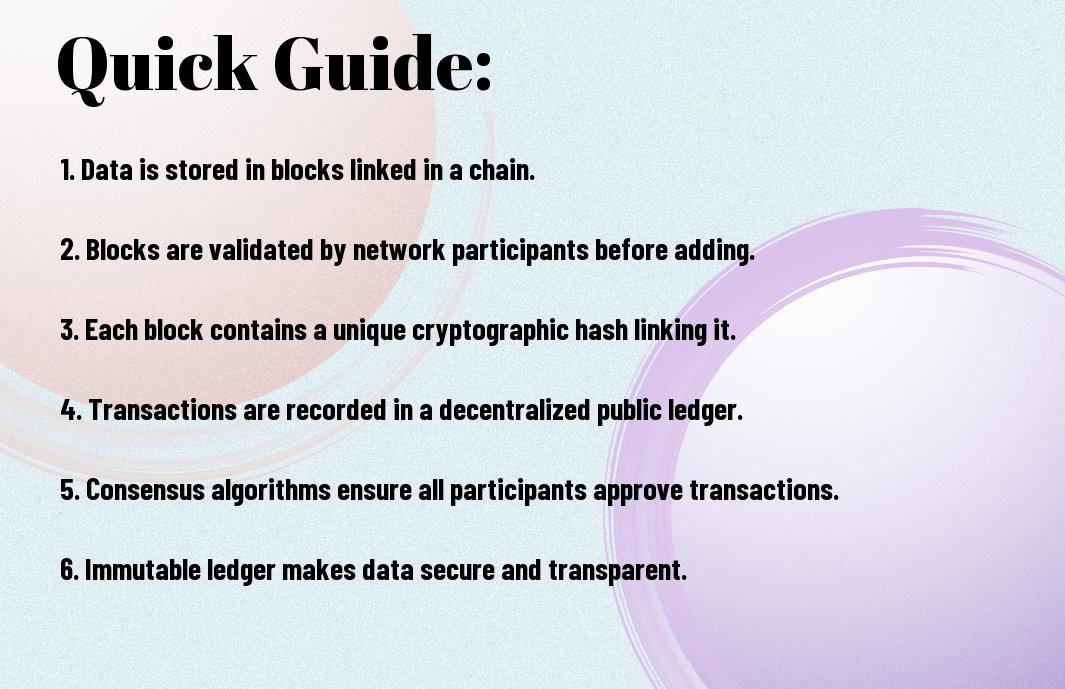Most of us have heard about blockchain technology, but how does it really work? In simple terms, a blockchain is a digital ledger that stores information in blocks that are linked together in a chain. What makes blockchain unique is its decentralized and secure nature. Each block contains transactions, and once added to the chain, it cannot be altered, making it immutabile. The system relies on consensus mechanisms to verify transactions, ensuring transparency and accountability throughout the network. This guide will investigate deeper into the inner workings of blockchain technology and how it is revolutionizing various industries.

Types of Blockchain Systems
Clearly, blockchain technology comes in various forms to suit different needs and preferences. Understanding the different types of blockchain systems is crucial for anyone looking to harness the power of this revolutionary technology. Below, we research into the four main categories of blockchain systems: Public Blockchains, Private Blockchains, Consortium Blockchains, and Permissioned Blockchains.
| Public Blockchains | Open to All |
| Private Blockchains | The Exclusive Networks |
| Consortium Blockchains | A Hybrid Approach |
| Permissioned Blockchains | Managed Access |
Public Blockchains: Open to All
Public blockchains are decentralized and open for anyone to participate, verify, and write transactions on the network. This openness ensures transparency and immutability of the data recorded on the blockchain. Transactions are public, and no single entity has control over the network, making it secure and resistant to tampering.
Private Blockchains: The Exclusive Networks
Blockchains that are private restrict access to only selected participants. These networks are ideal for businesses or organizations that require more control over the transactions and data shared. It allows for greater privacy and centralization of authority within the network.
Private blockchains may be more vulnerable to attacks due to their centralized nature, but they offer more efficiency and scalability for specific use cases.
Consortium Blockchains: A Hybrid Approach
Clearly, consortium blockchains combine the features of both public and private blockchains. They are semi-decentralized networks governed by a group of selected entities. This approach offers a balance between security and control, making it suitable for industries that require collaboration while maintaining data integrity.
Permissioned Blockchains: Managed Access
Private permissioned blockchains control access to the network and data, ensuring that only authorized participants can engage in transactions. This type of blockchain is common in enterprise settings where strict controls over data sharing and validation are necessary for compliance and operational reasons.
How Blockchain Works: A Step-by-Step Guide
Not only is blockchain technology revolutionizing the way we think about data and transactions, but it is also changing the landscape of various industries. Understanding how blockchain works is crucial to grasp its potential and applications.
The Making of a Block: From Transaction to Addition
| Making Transactions | Adding to the Block |
Making transactions on a blockchain involves creating a digital record of the exchange of assets or information. Once a group of transactions is verified, they are added to a block in the blockchain.
Ensuring Integrity: The Role of Cryptography
Now, cryptography plays a vital role in maintaining the security and integrity of the blockchain. Each block is linked to the previous one using cryptographic hashes, creating a secure and tamper-proof system.
Now, cryptographic algorithms ensure that data stored in blocks cannot be altered without being detected, providing a high level of security and trust in the system.
Network Consensus: Agreement at its Finest
| Transaction Verification | Consensus Protocol |
Transaction verification is a crucial part of the consensus mechanism in blockchain. By reaching an agreement on the validity of transactions, the network ensures the integrity of the entire system.
StepbyStep, network participants must agree on the validity of transactions before they are added to a block, ensuring consensus across all nodes in the network.
The Chain in Blockchain: Linking Blocks Securely
With each new block added to the chain, it is securely linked to the previous block using cryptographic hashes. This chaining mechanism creates a secure and transparent record of all transactions.
This linking of blocks ensures that any attempt to modify a block will alter all subsequent blocks, making it practically impossible to tamper with the data stored on the blockchain.
Embracing Blockchain: Tips and Best Practices
Your journey into blockchain technology can be rewarding if you follow these tips and best practices:
- Ensure thorough research before choosing a blockchain platform.
- Collaborate with experts in the field to understand the technology better.
- Regularly update your knowledge on blockchain trends and advancements.
Recognizing the importance of these tips will help you navigate the complexities of blockchain implementation successfully.
Factors to Consider Before Implementing Blockchain
Tips to consider before implementing blockchain technology:
- Analyze your organization’s needs and objectives.
- Evaluate the scalability and security features of the blockchain platform.
- Consider the potential impact on existing workflows and processes.
Thorough consideration of these factors is crucial for a successful blockchain implementation.
Pros and Cons: Weighing Blockchain for Your Needs
Pros and Cons of Blockchain Technology
| Pros | Cons |
| Increased transparency | Complex implementation process |
| Enhanced security | Scalability challenges |
| Reduced costs | Regulatory uncertainties |
When considering whether blockchain is suitable for your needs, weigh these pros and cons carefully. While the technology offers enhanced security and transparency, it also comes with implementation challenges and regulatory uncertainties. Understanding these factors will help you make informed decisions.

Summing up
As a reminder, blockchain technology operates on a decentralized network, storing information in blocks that are linked together in a chain. This provides a secure and transparent way to record transactions and information, eliminating the need for intermediaries. By utilizing cryptographic techniques and consensus algorithms, blockchain ensures data integrity and immutability. Through the process of mining, new blocks are added to the chain, creating a tamper-proof ledger. With its potential to revolutionize various industries, blockchain technology offers a promising future for secure, efficient, and trustworthy transactions.
FAQ
Q: What is blockchain technology?
A: Blockchain technology is a decentralized, distributed ledger system that allows digital transactions to be recorded securely and efficiently across a network of computers.
Q: How does blockchain technology work?
A: Blockchain works by creating a chain of blocks, each containing a list of transactions. These blocks are linked together and secured using cryptography, creating a tamper-proof record of all transactions.
Q: What are the benefits of blockchain technology?
A: Some benefits of blockchain technology include increased security, transparency, efficiency, and reduced costs. It eliminates the need for intermediaries in transactions and provides a decentralized system that is resistant to fraud and manipulation.
